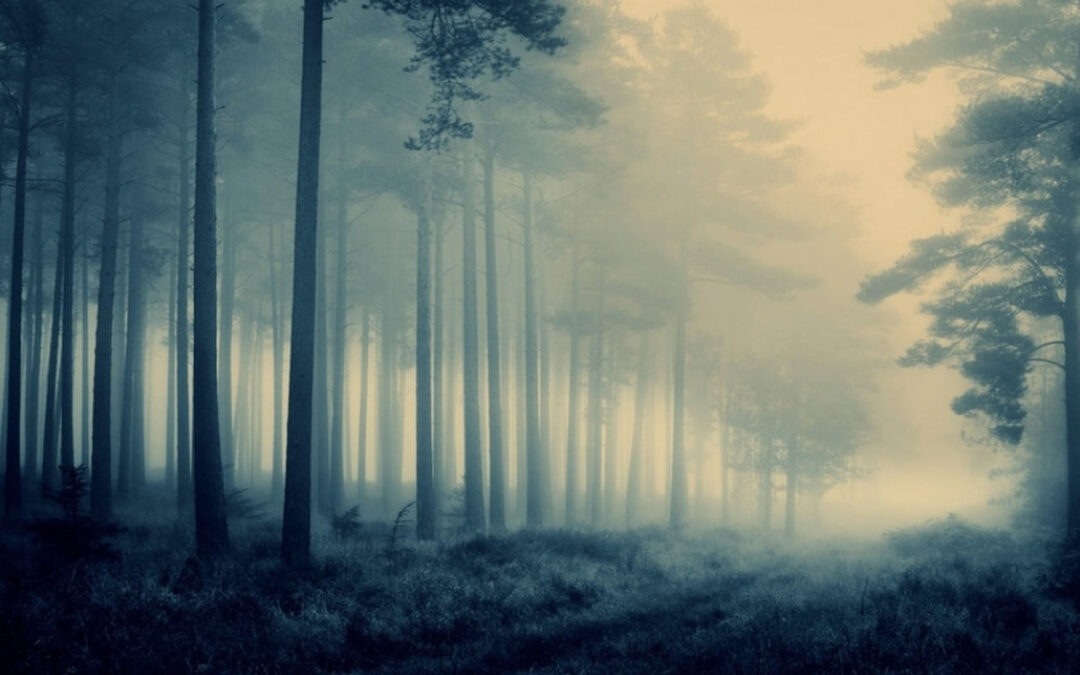
In my San Diego therapy office sits a landscape painting of a misty, shadowed forest. It hangs directly over my right shoulder, so when clients look at me, it’s always there in the background. The rest of the office is much brighter. Two of my favorites are framed drawings of San Diego’s most iconic coffee shops and breweries. The misty forest is an outlier. In a room filled with warmth and welcome, it’s a portal to something colder and less certain. That contrast is deliberate.
The Haunted Forest as a Transformative Place
Across literature, film, and legend, the dark forest is a place the hero must enter, even when fear says otherwise. Luke Skywalker goes into the haunted grove at Yoda’s urging, only to meet a vision of his own darkness. In The Lord of the Rings, Gimli reacts with shock when Merry and Pippin flee into Fangorn Forest, yet they emerge having found the wisdom and strength of the Ents. Hansel and Gretel, swallowed by the forest and unable to find their way home, work together to defeat the witch and reunite with their father.
Again and again, the pattern holds: the forest is where the danger is, but it’s also where the needed transformation happens.
Dark, haunted forests are staples in fairy tales, myths, and epic stories. They endure because they work on us symbolically. They work as powerful therapy metaphors because they point to parts of the psyche we’d rather not explore.
Into the Unknown: Facing Anxiety and Uncertainty in Therapy
Our minds are meaning-making, prediction-generating machines. Long before humans climbed ourselves out of the food chain, this ability to imagine possible threats before they arrived kept us alive.
While other mammals depended only on their five senses in the present moment, we had an extra survival tool: imagination. We could picture where danger might come from and plan accordingly. That was a huge advantage then, but in modern life, it often works against us.
If a deer wanders into a foggy forest, it relies on smell, sound, and sight to judge if it’s safe. If a human sees that same forest, we tell ourselves stories of ghosts, monsters, serial killers, and witches. Our brains spin entire narratives out of what’s unclear, and those stories tend to lean toward the frightening with the goal of us getting one message loud and clear: stay away.
Why I Keep the Forest Painting in My Office
Therapy, at its best, puts people on the threshold of their own haunted forest. Whether that’s family history, unprocessed grief, unnamed relational patterns, addictions, or habits they can’t yet bring themselves to name, it’s tempting to stay outside where it’s bright and comfortable.In counseling, avoidance is understandable, but therapy invites clients to step into that haunted forest with support.
But like the heroes who step inside anyway, the people who do this work often find the courage, clarity, and resources they’ve been missing. Not out in the sunny meadow, but right there among the shadows.
Cautionary Tales
Not every trip into the dark ends well. Take Ichabod Crane in The Legend of Sleepy Hollow. On paper, he follows the same setup as a mythic hero. He enters a mysterious, haunted landscape and encounters a terrifying figure. But unlike Luke, Merry, or Gretel, he never finds his courageous spirit and instead is driven by fear.
He misreads the nature of the threat. In a mythic lens, the monster is often both real and symbolic, a mirror of the hero’s inner fears. Ichabod never engages with it that way. He reacts only as prey: running, panicking, hoping to escape. There’s no confrontation, no courage, no integration.
For this reason, he never returns. The forest does, in fact, swallow him.
His story is a cautionary tale. Entering the haunted forest without courage, clarity, or a willingness to change often ends with the forest keeping you.
The Treasure You Seek
At Sonder Therapy Group in San Diego, I help clients face their own haunted forests — whether grief, anxiety, trauma, or relationship struggles — with courage and clarity. I help them avoid the fate of Ichabod Crane, who mistook the journey for a shortcut and the forest for a dead end, when it could have been the place where everything changed. If you want to learn more about my team and I work with individuals in therapy, you can find out here.
Each of us will be confronted by haunted forests of our own we’d rather avoid and yet venturing into such a place is exactly where we will find the resolution we’re ultimately looking for. As Joseph Campbell once put it:
“The cave (or forest) you fear to enter holds the treasure you seek.”
FAQ
What does therapy feel like when you’re facing hard memories?
Therapy can feel uncomfortable at first, especially when painful memories or emotions surface. But with a therapist guiding the process, clients often discover that naming and facing those memories reduces their power. Over time, what once felt overwhelming becomes manageable, and growth starts to take root.
How can counseling help me confront fears or trauma?
In counseling, fears and traumatic experiences are approached gradually and safely, not all at once. Through trauma-informed therapy, clients learn coping tools, build resilience, and process their stories in a way that helps them feel more grounded. Many find that facing their fears with support leads to lasting relief and transformation.
Is online therapy as effective as in-person sessions?
For many people, online therapy can be just as effective as meeting face-to-face. Telehealth counseling allows clients in San Diego and throughout California to access therapy from home while still getting the same level of care and connection. It’s especially helpful for people with busy schedules, parents, or those who prefer the privacy of their own space. For some people face-to-face therapy is much preferred and I totally get it. But some people don’t mind and Telehealth can feel every bit as comfortable as in person.

